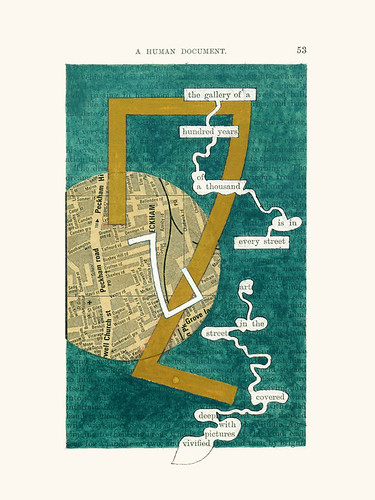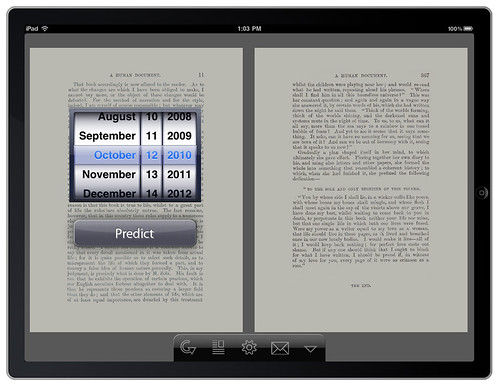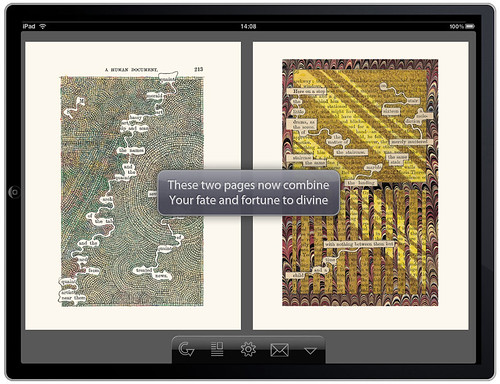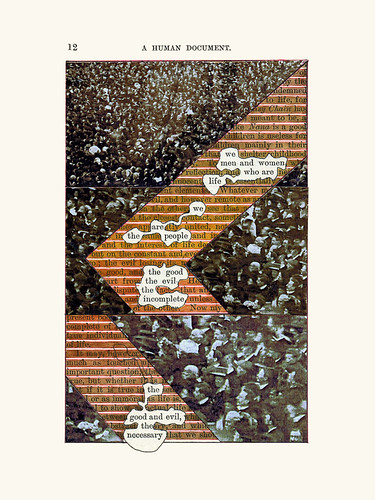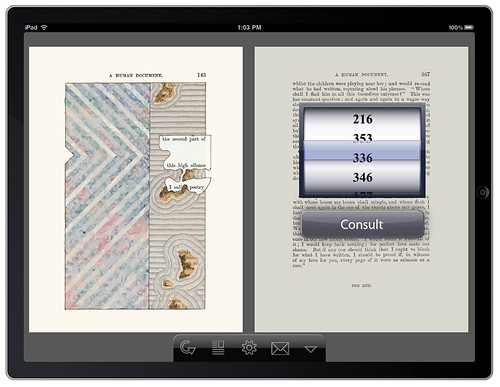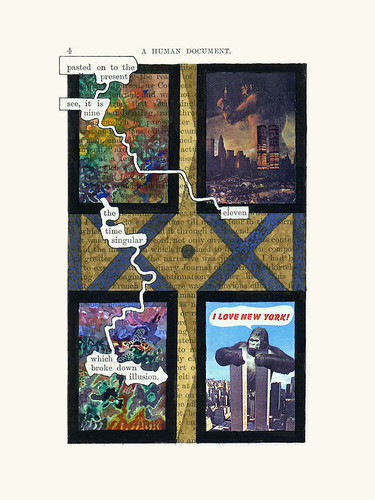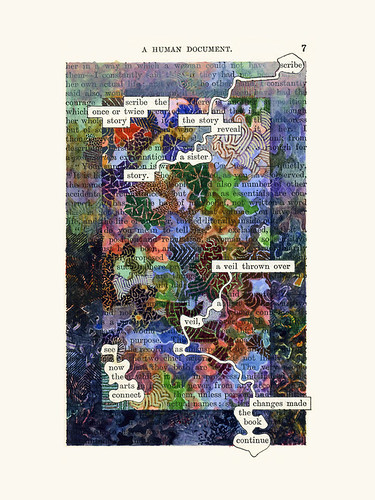Tuesday, 4:47pm
16 November 2010
The app of A Humument
the apps department
Book design
Illustration
New media
Technology
Typography
Visual culture
‘The iPad is one of the oldest things in the world ... a pad or a slate.’
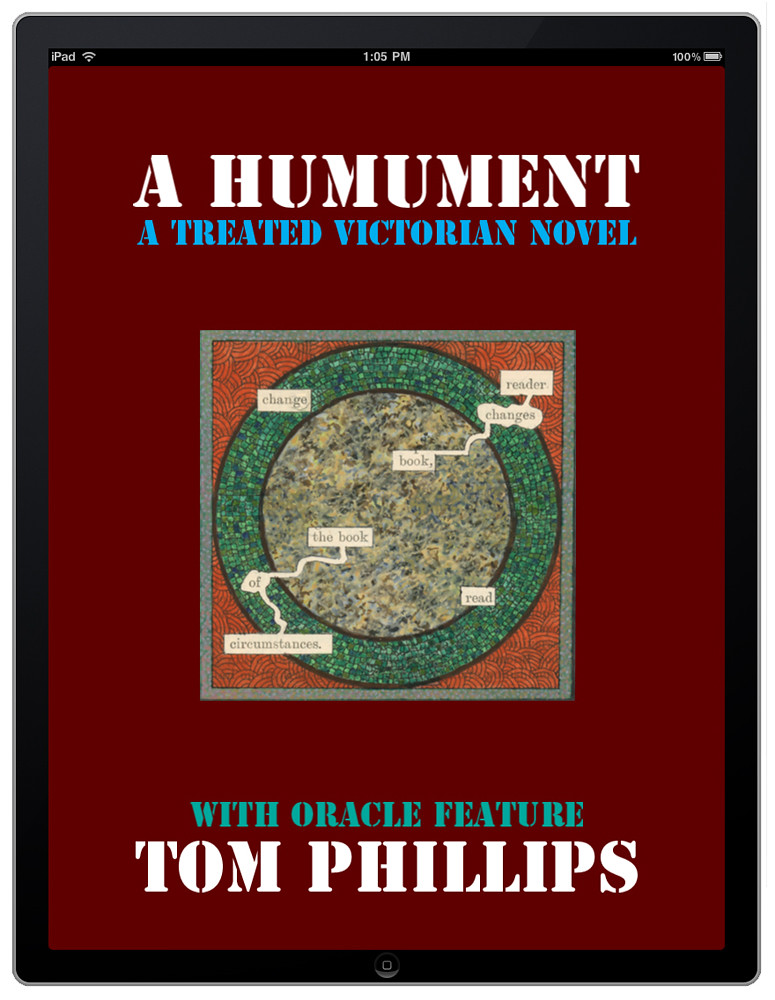
Tom Phillips’ A Humument is an artists’ book made by defacing (and hence deconstructing) an obscure Victorian novel, W.H. Mallock’s A Human Document, writes John L. Walters. (See Archive, Eye no. 18 vol. 5.)
Phillips outlines white ‘rivers’ within the original text setting to link words of his choosing, revealing new phrases – ‘we are the people’, ‘art took ornament as water found desert’ – while applying ink, paint and collaged elements to each numbered page.
After four printed editions for Thames & Hudson (and the tiny Heart of a Humument), Phillips has made an iPad version, now available on iTunes. I interviewed him in the kitchen of his Peckham house on bonfire night, while rockets and bangers whizzed and crackled in the streets outside. Phillips is something of a local hero in our part of Southeast London, which he celebrates in the mighty 20 Sites n Years project.
JLW: You said that this app is the kind of thing you imagined when you first started working on A Humument in the 1960s …
Tom Phillips: I was very into the I Ching under the influence of my friend John Cage, so I thought of it as an oracle. The meaning is suspended in each page, so it can be used like the I Ching. I didn’t think of any way it could really happen, until more than 40 years later.
JLW: You could have made a set of loose-leaf cards …
TP: Yes, I could have done all sorts of things, but it had to be first and foremost a book.
Suddenly this machine [the iPad], which features the pages at exactly the same size, comes around, and you can fiddle about, and it can have its own ‘roulette wheel’ (below) which gives you chance pages. So these oracle ideas popped back into my mind with force.
JLW: When did you start working on the app?
TP: As soon as I got an iPad. I got one in order to do it … my visual tongue was hanging out. I saw someone demonstrating something, showing off, and like Mr Toad when he saw the motor car went ‘poop-poop’ – I had to get one of these.
So part of the idea of the oracle was to give me an alibi, an excuse to buy the iPad.
JLW: Had you thought of doing the oracle idea on your website?
TP: Not really. I’m a bit clumsy about websites and I’m dependent on other people to do them … [The app] seemed a really nice way of bringing it up to date. So the iPad version is much more up to date than the last printed version. I’m a rather primitive Web user.
JLW: I just interviewed the designer Paula Scher in Eye 77, who hates computers but loves the iPad.
TP: I’m a bit like that. It’s different things at different times, a serious research tool, or a communication device, but it’s a toy, I can play with it and find things I didn’t know existed.
JLW: It’s like a cross between a stained glass window and a book.
TP: It’s also one of the oldest things in the world, as its called, a pad or a slate. This is a child’s slate like the one I had when I was five years old.
JLW: Really? You had a slate at school?
TP: [film comedy voice] It was the war, guv – we didn’t have no fancy paper.
JLW: So you had a slate and chalk?
TP: Yes. If you’re going to write ‘f’ a thousand times, it’s a waste of paper. If you look at the old tablets from Koranic schools, where people used to write into wax with and a lot of them have survived. And they still use them, wooden ones, in Africa. I’ve seen them. Exactly the size they are. Fits the hand [I sound like a walking advert for it!]. It’s the same weight as the slate used to be, a very heavy thing for a little child.
JLW: I think there are plans to make smaller ones and bigger tablets, but this seems perfect for A Humument.
TP: [placing one of the paperback editions on the iPad]. It couldn’t be better. . .
JLW: What you’re showing me here is a new means of disseminating a work, a book, a work of art. Could you imagine using the iPad to make work?
TP: Yes. That’s the next step. I haven’t done what David Hockney’s done … David makes these beautiful drawings all the time.
JLW: Using Brushes …
TP: He’s pretty clever at that kind of thing. I used Photoshop in its old days, making a TV film about Dante. Recently I made a portrait like that of Susan Greenfield, which is in the National Portrait gallery.
But nothing has been quite like a sketchbook until this – as soon as I know how to save things. I erase everything except the things I don’t want … perhaps Steve Jobs can tell me how to fix that.
JLW: Is there any routine in the way that you update A Humument?
TP: Each edition has at least 50 new pages. I do perhaps one a month, on average. It’s an old friend, that book. I have lots of falling-apart copies.
JLW: And you chose the book at random. Did you realise that it would become such a useful tool.
TP: No, it was a high-risk choice. I was with the late (alas) Ron [R. G.] Kitaj and we were shopping in Peckham in Austin’s furniture repository, not far from where we’re sitting now, and I said ‘Ron, I’ll get the first book I find for thruppence and spend the rest of my life working on it. And as luck would have it, the title that immediately drew my attention in the row of books stared out at me, A Human Document.
More about the artist at tomphillips.co.uk and 57talfourd.com.
Read Tom Phillips’ Eye article about ‘Tart cards’ in Eye 34.
Eye magazine is available from all good design bookshops and at the online Eye shop, where you can order subscriptions, single issues and back issues.

